Gold Provenance in Placers from Pureo Area, Southern Chile Coastal Cordillera, and Their Relationship with Paleozoic Metamorphic Rocks
Abstract
:1. Introduction
2. Geological Background
3. Materials and Methods
3.1. Sample Collection
3.2. Morphological Analysis
3.3. Microchemical Analysis
4. Results
4.1. Particle Morphology
4.2. Microchemical Characteristics
4.2.1. Native Gold Composition and Internal Chemical Zonations
4.2.2. Mineral Inclusions
5. Discussion
5.1. Particle Morphology and Transport Distance
5.2. Microchemistry and Gold Sub-Populations
5.3. Mineralization Styles in the Coastal Cordillera and Possible Sources of Gold
6. Conclusions
- The morphological characteristics of Pureo gold particles indicate a limited transport, with distances no further than 15 km, probably in the range of 1–8 km, consistent with a local provenance restricted to the metamorphic rocks of the Coastal Cordillera.
- Particle microchemical characteristics, such as native gold composition and mineral inclusions, allowed us to identify two compositional sub-populations. These compositional types could be associated with two contrasting primary sources, formed by different types of magmatic-hydrothermal and/or metamorphic processes in the Coastal Cordillera. The possible sources of gold can be correlated with two types of hypogene mineralization styles observed in the study area: metamorphosed hydrothermal deposits of the BMMC (metamorphosed Kieslager massive sulfide deposits and their related exhalites) and subsequent magmatic-hydrothermal processes (Cenozoic intrusive activity and related hydrothermal systems).
- Both characteristics allowed us to conclude a local origin of the gold, restricted to the erosion of rocks present in the Coastal Cordillera. Because some manifestations of possible primary gold source types remain locally and regionally preserved, it is possible that undiscovered deposits exist in this and other regions of the Coastal Cordillera. The microchemical characteristics defined in this work could provide a basis for further exploration works. Therefore, additional work could focus on morphological and microchemical studies of gold particles from other placer deposits in Coastal Cordillera and placers in active rivers.
Author Contributions
Funding
Acknowledgments
Conflicts of Interest
References
- Boyle, R.W. Gold: History and Genesis of Deposits, 1st ed.; Springer: New York, NY, USA, 1987. [Google Scholar]
- Knight, J.B.; Morison, S.R.; Mortensen, J.K. The Relationship between Placer Gold Particle Shape, Rimming, and Distance of Fluvial Transport as Exemplified by Gold from the Klondike District, Yukon Territory, Canada. Econ. Geol. 1999, 94, 635–648. [Google Scholar] [CrossRef]
- Townley, B.K.; Hérail, G.; Maksaev, V.; Palacios, C.; de Parseval, P.; Sepulveda, F.; Orellana, R.; Rivas, P.; Ulloa, C. Gold Grain Morphology and Composition as an Exploration Tool: Application to Gold Exploration in Covered Areas. Geochem. Explor. Environ. Anal. 2003, 3, 29–38. [Google Scholar] [CrossRef]
- Hérail, G.; Fornari, M.; Viscarra, G.; Miranda, V. Morphological and Chemical Evolution of Gold Grains during the Formation of a Polygenic Fluviatile Placer: The Mio-Pleistocene Tipuani Placer Example (Andes, Bolivia). Chron. Rech. Min. 1990, 500, 41–49. [Google Scholar]
- Youngson, J.H.; Craw, D. Variation in Placer Style, Gold Morphology, and Gold Particle Behavior down Gravel Bed-Load Rivers; an Example from the Shotover/Arrow-Kawarau-Clutha River System, Otago, New Zealand. Econ. Geol. 1999, 94, 615–633. [Google Scholar] [CrossRef]
- Chapman, R.; Leake, B.; Styles, M. Microchemical Characterization of Alluvial Gold Grains as an Exploration Tool. Gold Bull. 2002, 35, 53–65. [Google Scholar] [CrossRef]
- Chapman, R.J.; Banks, D.A.; Styles, M.T.; Walshaw, R.D.; Piazolo, S.; Morgan, D.J.; Grimshaw, M.R.; Spence-Jones, C.P.; Matthews, T.J.; Borovinskaya, O. Chemical and Physical Heterogeneity within Native Gold: Implications for the Design of Gold Particle Studies. Miner. Depos. 2021, 56, 1563–1588. [Google Scholar] [CrossRef]
- Chapman, R.J.; Leake, R.C.; Bond, D.P.G.; Stedra, V.; Fairgrieve, B. Chemical and Mineralogical Signatures of Gold Formed in Oxidizing Chloride Hydrothermal Systems and Their Significance within Populations of Placer Gold Grains Collected during Reconnaissance. Econ. Geol. 2009, 104, 563–585. [Google Scholar] [CrossRef]
- Rivera, G. Entre Circas y Cañuelas: Historia de Los Pirquineros Auríferos de Mariquina, Siglos XVI al XXI, 1st ed.; San José de la Mariquina, Valdivia, Chile, 2017; Available online: https://http://2016.literaturalosrios.cl/catalogo/r1112/entre_circas_y_cauelas_historia_de_los_pirquineros_aurferos_de_mariquina_siglos_xvi_al_xxi (accessed on 6 September 2022).
- Ordoñez, A. Oro detrítico en la región de Los Lagos (39–42° S): Mecanismos de transporte y proveniencia. Serv. Natl. Geol. Miner. (Boletin) 2000, 56, 1–40. [Google Scholar]
- Zuccone, A. Los placeres auríferos de Madre de Dios y el ambiente metamórfico circundante. Bachelor’s Thesis, Universidad de Chile, Santiago, Chile, 1988. [Google Scholar]
- Muñoz, V. El Basamento Metamórfico Paleozoico, Serie Occidental en la Hoja Queule, IX y X Región, Chile. Condiciones Presión-Temperatura del Metamorfismo. Master’s Thesis, Universidad de Chile, Santiago, Chile, 2007. [Google Scholar]
- SERNAGEOMIN. Estudio Geológico-Económico de la X Región Norte, Chile; Servicio Nacional de Geología y Minería: Santiago, Chile, 1998; pp. 1–158.
- Duhart, P.; McDonough, M.; Muñoz, J.; Martin, M.; Villeneuve, M. El Complejo Metamórfico Bahía Mansa en la cordillera de la Costa del centro-sur de Chile (39°30′–42°00′ S): Geocronología K-Ar, 40Ar/39Ar y U-Pb e implicancias en la evolución del margen sur-occidental de Gondwana. Rev. Geol. Chile 2001, 28, 179–208. [Google Scholar] [CrossRef]
- Glodny, J.; Lohrmann, J.; Echtler, H.; Gräfe, K.; Seifert, W.; Collao, S.; Figueroa, O. Internal Dynamics of a Paleoaccretionary Wedge: Insights from Combined Isotope Tectonochronology and Sandbox Modelling of the South-Central Chilean Forearc. Earth Planet. Sci. Lett. 2005, 231, 23–39. [Google Scholar] [CrossRef]
- Quiroz, D.; Duhart, P.; Crignola, P. Geología del área Lanco-Loncoche, regiones de La Araucanía y de Los Ríos, escala 1:100.000, Carta Geológica de Chile, Serie Geología Básica 106. Serv. Natl. Geol. Miner. 2007, 106, 1–21. [Google Scholar]
- Godoy, E.; Kato, T. Late Paleozoic Serpentinites and Mafic Schists from the Coast Range Accretionary Complex, Central Chile: Their Relation to Aeromagnetic Anomalies. Geol. Rundsch. 1990, 79, 121–130. [Google Scholar] [CrossRef]
- Collao, S.; Alfaro, G. Mineralización sulfurada de hierro, cobre y zinc en la Cordillera de la Costa, sur de Chile. Rev. Geol. Chile 1982, 15, 41–47. [Google Scholar]
- Quiroz, D.; Duhart, P. Geología del área Queule-Toltén, regiones de La Araucanía y de Los Ríos, escala 1:100.000, Carta Geológica de Chile, Serie Geología Básica 110. Serv. Natl. Geol. Miner. 2008, 110, 1–22. [Google Scholar]
- Garroz, B. Estudio del Basamento Metamórfico e Identificación de las Principales Fuentes de oro de los Placeres de Mariquina, región de Los Ríos, Chile. Bachelor’s Thesis, Universidad Austral de Chile, Valdivia, Chile, 2022. [Google Scholar]
- Collao, S.; Alfaro, G.; Hayashi, K. Banded Iron Formation and Massive Sulfide Orebodies, South-Central Chile: Geologic and Isotopic Aspects. In Stratabound Ore Deposits in the Andes; Fontboté, L., Amstutz, G.C., Cardozo, M., Cedillo, E., Frutos, J., Eds.; Springer: Berlin, Heidelberg, 1990; pp. 209–219. [Google Scholar]
- Schira, W.; Amstutz, G.C.; Fontboté, L. The Pirén Alto Cu-(Zn) Massive Sulfide Occurrence in South-Central Chile—A Kieslager-Type Mineralization in a Paleozoic Ensialic Mature Marginal Basin Setting. In Stratabound Ore Deposits in the Andes; Fontboté, L., Amstutz, G.C., Cardozo, M., Cedillo, E., Frutos, J., Eds.; Springer: Berlin, Heidelberg, 1990; pp. 229–251. [Google Scholar]
- Willner, A.P.; Pawlig, S.; Massonne, H.-J.; Herve, F. Metamorphic Evolution of Spessartine Quartzites (Coticules) in the High-Pressure, Low-Temperature Complex at Bahia Mansa, Coastal Cordillera of South-Central Chile. Can. Mineral. 2001, 39, 1547–1569. [Google Scholar] [CrossRef]
- Avila, A. Proyecto Piren, Informe de Avance. Inedit Report; Minerales Sierra Morena S.A.: Valdivia, Chile, 1990. [Google Scholar]
- Troncoso, R.; Cisternas, M.E.; Alfaro, G.; Vukasovic, V. Antecedentes sobre volcanismo terciario, cordillera de la costa, X Región, Chile. In Proceedings of the VII Congreso Geológico Chileno, Concepción, Chile, 17–21 October 1994; Volume 1, pp. 205–209. [Google Scholar]
- Duhart, P.; Antinao, J.L.; Clayton, J.; Elgueta, S.; Crignola, P.; McDonough, M. Geología del área Los Lagos-Malalhue, escala 1:100.000, Carta Geológica de Chile, Serie Geología Básica 81. Serv. Natl. Geol. Miner. 2003, 81, 1–30. [Google Scholar]
- Yeend, W.E. Gold in Placer Deposits; US Government Printing Office: Washington, DC, USA, 1990; p. 19.
- Peebles, F. Estudio Preliminar de las Pertenencias Mineras en los Sectores Madre de Dios y El Roble, Provincia de Valdivia; Instituto de Investigaciones Geológicas: Santiago, Chile, 1976; pp. 1–8. [Google Scholar]
- Agnerian, H. Report on Madre de Dios Placer Gold Project, Chile. Internal Report; Global Gold Company: Berlin, Germany, 2007; pp. 1–52. [Google Scholar]
- Crawford, E.C.; Mortensen, J.K. An ImageJ Plugin for the Rapid Morphological Characterization of Separated Particles and an Initial Application to Placer Gold Analysis. Comput. Geosci. 2009, 35, 347–359. [Google Scholar] [CrossRef]
- Schindelin, J.; Arganda-Carreras, I.; Frise, E.; Kaynig, V.; Longair, M.; Pietzsch, T.; Preibisch, S.; Rueden, C.; Saalfeld, S.; Schmid, B.; et al. Fiji: An Open-Source Platform for Biological-Image Analysis. Nat. Methods 2012, 9, 676–682. [Google Scholar] [CrossRef]
- Cailleux, A.; Tricart, J. Initiation à l’étude Des Sables et Des Galets, 1st ed.; Centre de la Documentation Universitaire: Paris, France, 1959; Volume 1. [Google Scholar]
- Shilo, N.A.; Shumilov, Y.V. New Experimental Data on Settling of Gold Particles in Water. Dokl. Akad. Nauk SSR (Earth Sci. Sect.) 1970, 195, 184–187. [Google Scholar]
- dos Santos Alves, K.; Barrios Sánchez, S.; Gómez Barreiro, J.; Merinero Palomares, R.; Compaña Prieto, J.M. Morphological and Compositional Analysis of Alluvial Gold: The Fresnedoso Gold Placer (Spain). Ore Geol. Rev. 2020, 121, 103489. [Google Scholar] [CrossRef]
- Hofmann, H.J. Grain-Shape Indices and Isometric Graphs. J. Sediment. Res. 1994, A64, 916–920. [Google Scholar] [CrossRef]
- Crawford, E.C. Klondike Placer Gold: New Tools for Examining Morphology, Composition and Crystallinity. Master’s Thesis, University of British Columbia, Vancouver, BC, Canada, 2007. [Google Scholar]
- Wrighton, T.M. Placer Gold Microchemical Characterization And Shape Analysis Applied As An Exploration Tool In Western Yukon. Master’s Thesis, University of British Columbia, Vancouver, BC, Canada, 2013. [Google Scholar]
- Groen, J.C.; Craig, J.R.; Rimstidt, J.D. Gold-Rich Rim Formation on Electrum Grains in Placers. Can. Mineral. 1990, 28, 207–228. [Google Scholar]
- Krupp, R.E.; Weiser, T. On the Stability of Gold-Silver Alloys in the Weathering Environment. Miner. Depos. 1992, 27, 268–275. [Google Scholar] [CrossRef]
- Chapman, R.J.; Mortensen, J.K. Application of Microchemical Characterization of Placer Gold Grains to Exploration for Epithermal Gold Mineralization in Regions of Poor Exposure. J. Geochem. Explor. 2006, 91, 1–26. [Google Scholar] [CrossRef]
- Leake, R.C.; Chapman, R.J.; Bland, D.J.; Stone, P.; Cameron, D.G.; Styles, M.T. The Origin of Alluvial Gold in the Leadhills Area of Scotland: Evidence from Interpretation of Internal Chemical Characteristics. J. Geochem. Explor. 1998, 63, 7–36. [Google Scholar] [CrossRef]
- Chapman, R.J.; Leake, R.C.; Moles, N.R. The Use of Microchemical Analysis of Alluvial Gold Grains in Mineral Exploration: Experiences in Britain and Ireland. J. Geochem. Explor. 2000, 71, 241–268. [Google Scholar] [CrossRef]
- Potter, M.; Styles, M.T. Gold Characterisation as a Guide to Bedrock Sources for the Estero Hondo Alluvial Gold Mine, Western Ecuador. Appl. Earth Sci. 2003, 112, 297–304. [Google Scholar] [CrossRef]
- Mackenzie, D.J.; Craw, D. The Mercury and Silver Contents of Gold in Quartz Vein Deposits, Otago Schist, New Zealand. N. Z. J. Geol. Geophys. 2005, 48, 265–278. [Google Scholar] [CrossRef]
- Moles, N.R.; Chapman, R.J. Integration of Detrital Gold Microchemistry, Heavy Mineral Distribution, and Sediment Geochemistry to Clarify Regional Metallogeny in Glaciated Terrains: Application in the Caledonides of Southeast Ireland. Econ. Geol. 2019, 114, 207–232. [Google Scholar] [CrossRef]
- Wierchowiec, J. Morphology and Chemistry of Placer Gold Grains—Indicators of the Origin of the Placers: An Example from the East Sudetic Foreland, Poland. Acta Geol. Pol. 2002, 52, 563–576. [Google Scholar]
- Butt, C.R.M.; Hough, R.M.; Verrall, M. Gold Nuggets: The inside Story. Ore Energy Resour. Geol. 2020, 4–5, 100009. [Google Scholar] [CrossRef]
- Nichol, I.; Hale, M.; Fletcher, W.K. Drainage Geochemistry in Gold Exploration. In Drainage Geochemistry; Hale, M., Plant, J.A., Eds.; Handbook of Exploration Geochemistry; Elsevier: Amsterdam, The Netherlands, 1994; Volume 6, pp. 499–557. ISBN 978-0-444-81854-6. [Google Scholar]
- Rivera, J.; Reich, M.; Schoenberg, R.; González-Jiménez, J.M.; Barra, F.; Aiglsperger, T.; Proenza, J.A.; Carretier, S. Platinum-Group Element and Gold Enrichment in Soils Monitored by Chromium Stable Isotopes during Weathering of Ultramafic Rocks. Chem. Geol. 2018, 499, 84–99. [Google Scholar] [CrossRef]
- Healy, R.E.; Petruk, W. Petrology of Au-Ag-Hg Alloy and “Invisible” Gold in the Troutlake Massive Sulfide Deposit, Flin Flon, Manitoba. Can. Mineral. 1990, 28, 189–206. [Google Scholar]
- Huston, D.L.; Bottrill, R.S.; Creelman, R.A.; Zaw, K.; Ramsden, T.R.; Rand, S.W.; Gemmell, J.B.; Jablonski, W.; Sie, S.H.; Large, R.R. Geologic and Geochemical Controls on the Mineralogy and Grain Size of Gold-Bearing Phases, Eastern Australian Volcanic-Hosted Massive Sulfide Deposits. Econ. Geol. 1992, 87, 542–563. [Google Scholar] [CrossRef]
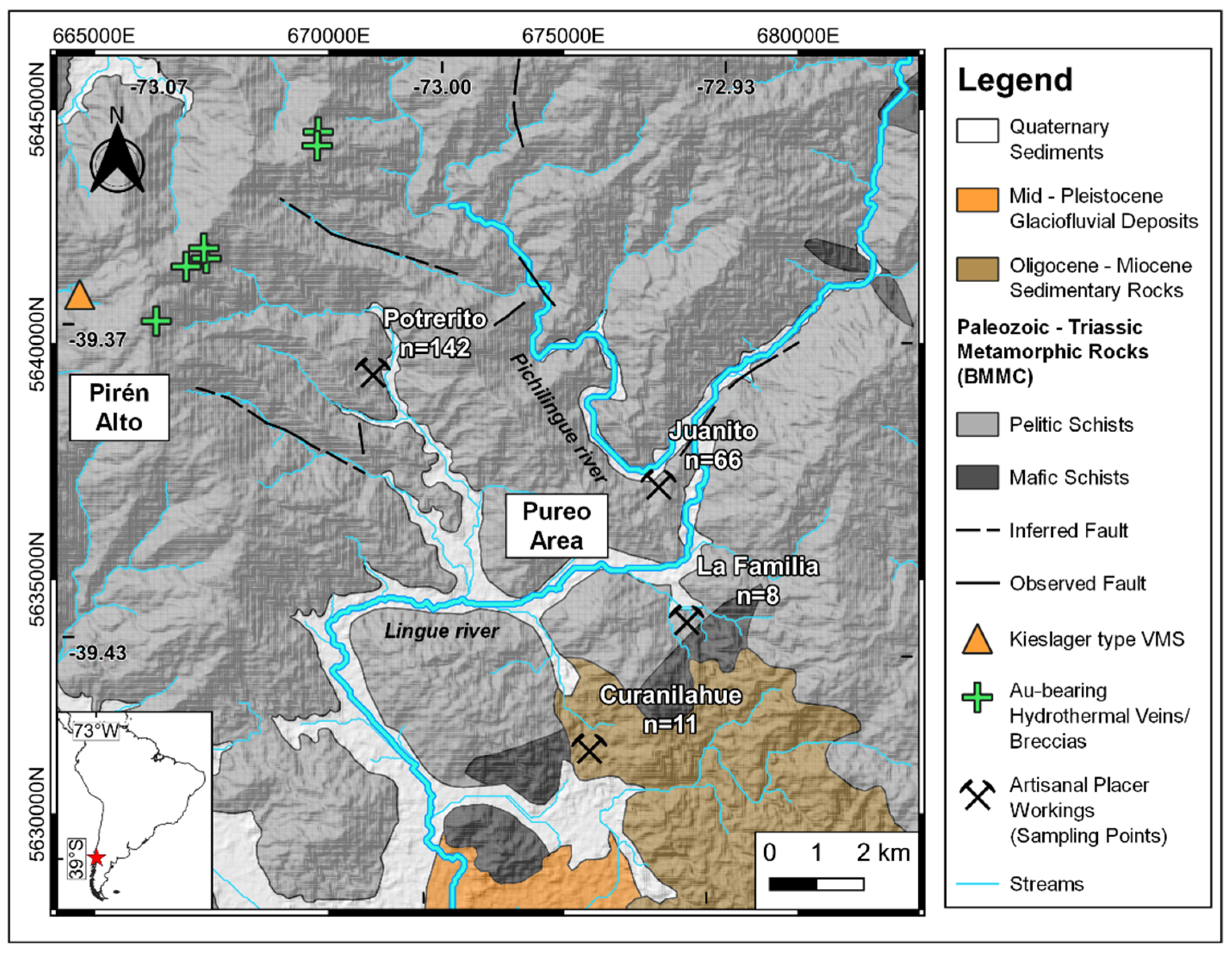
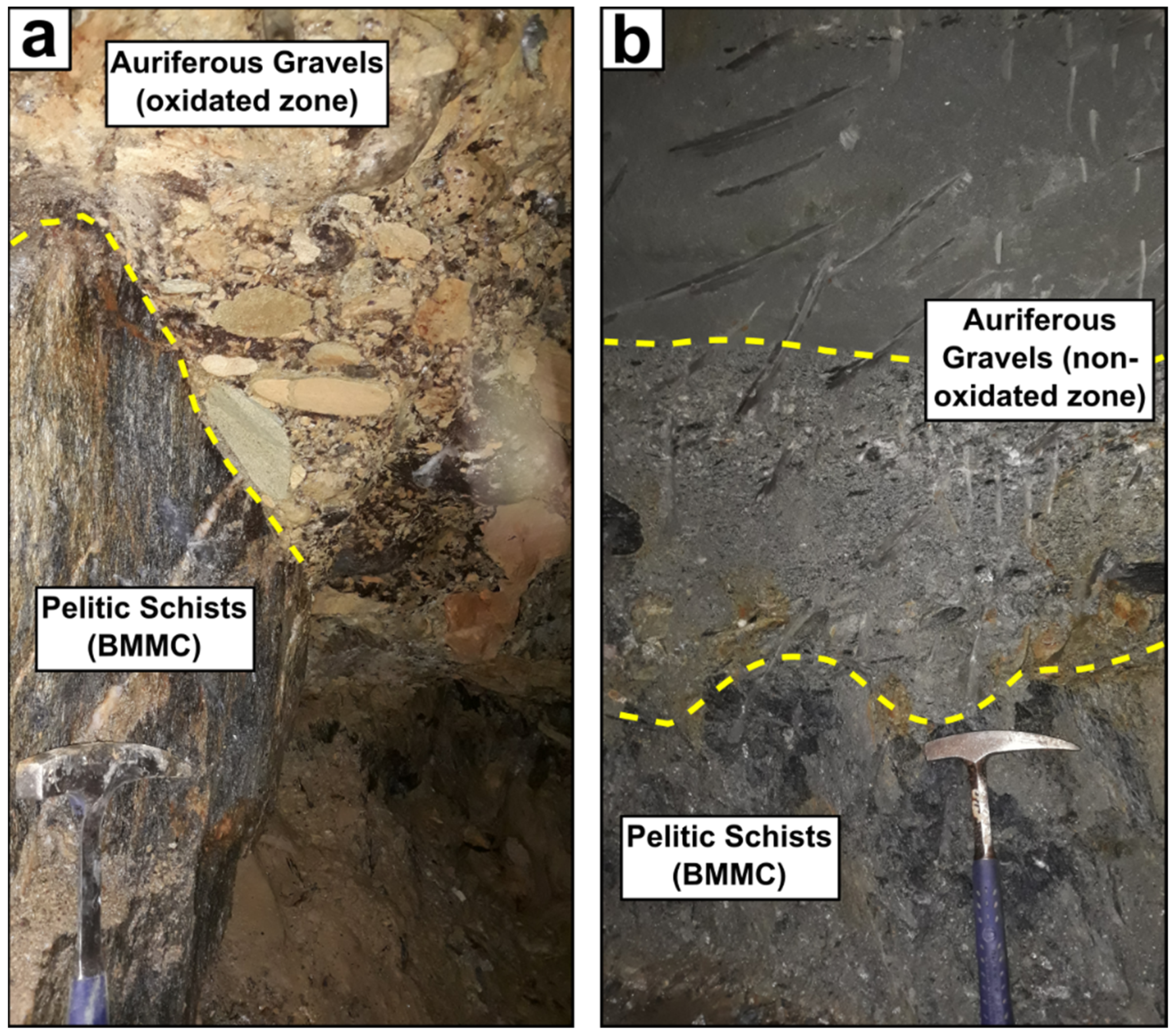


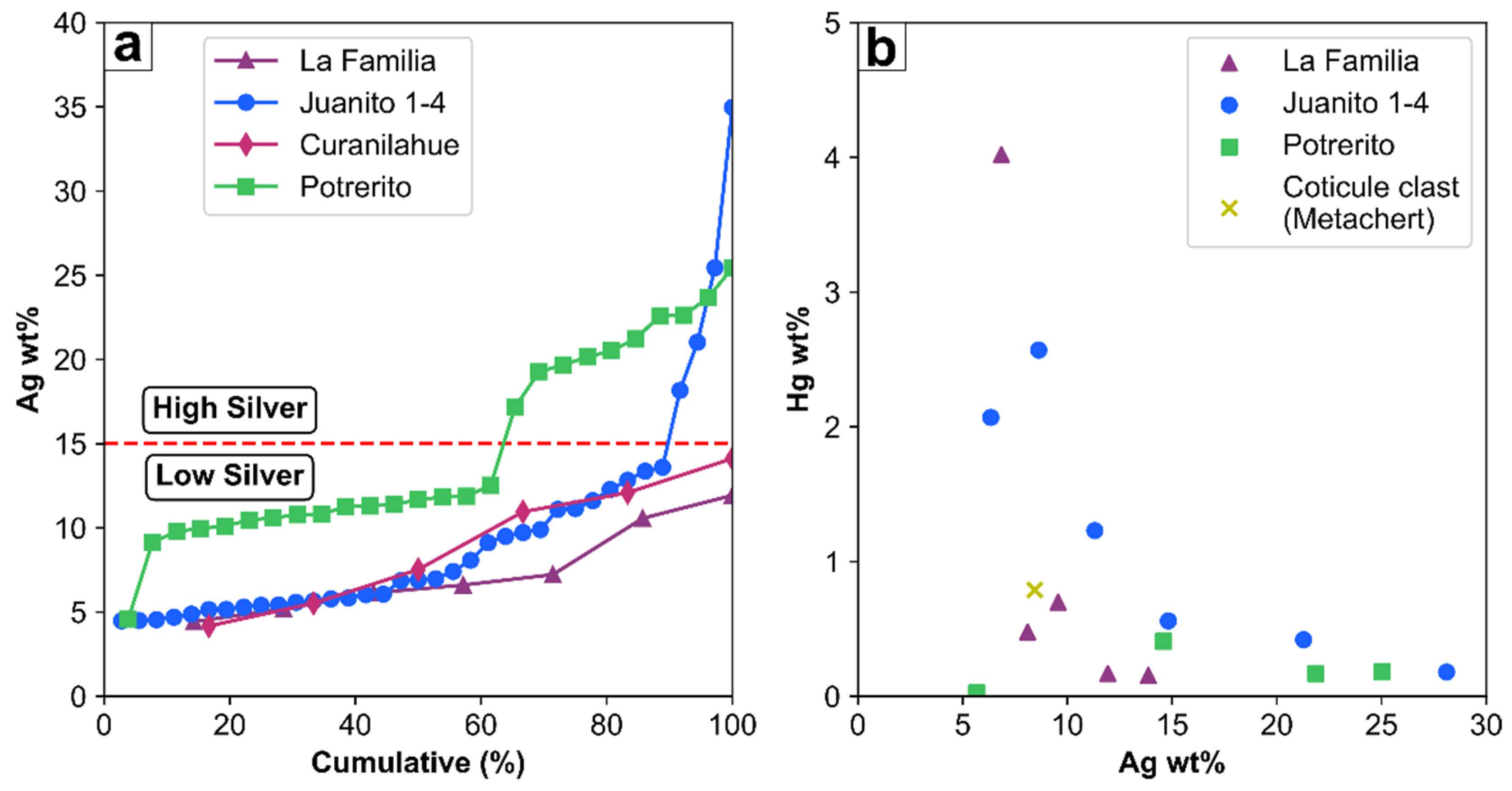

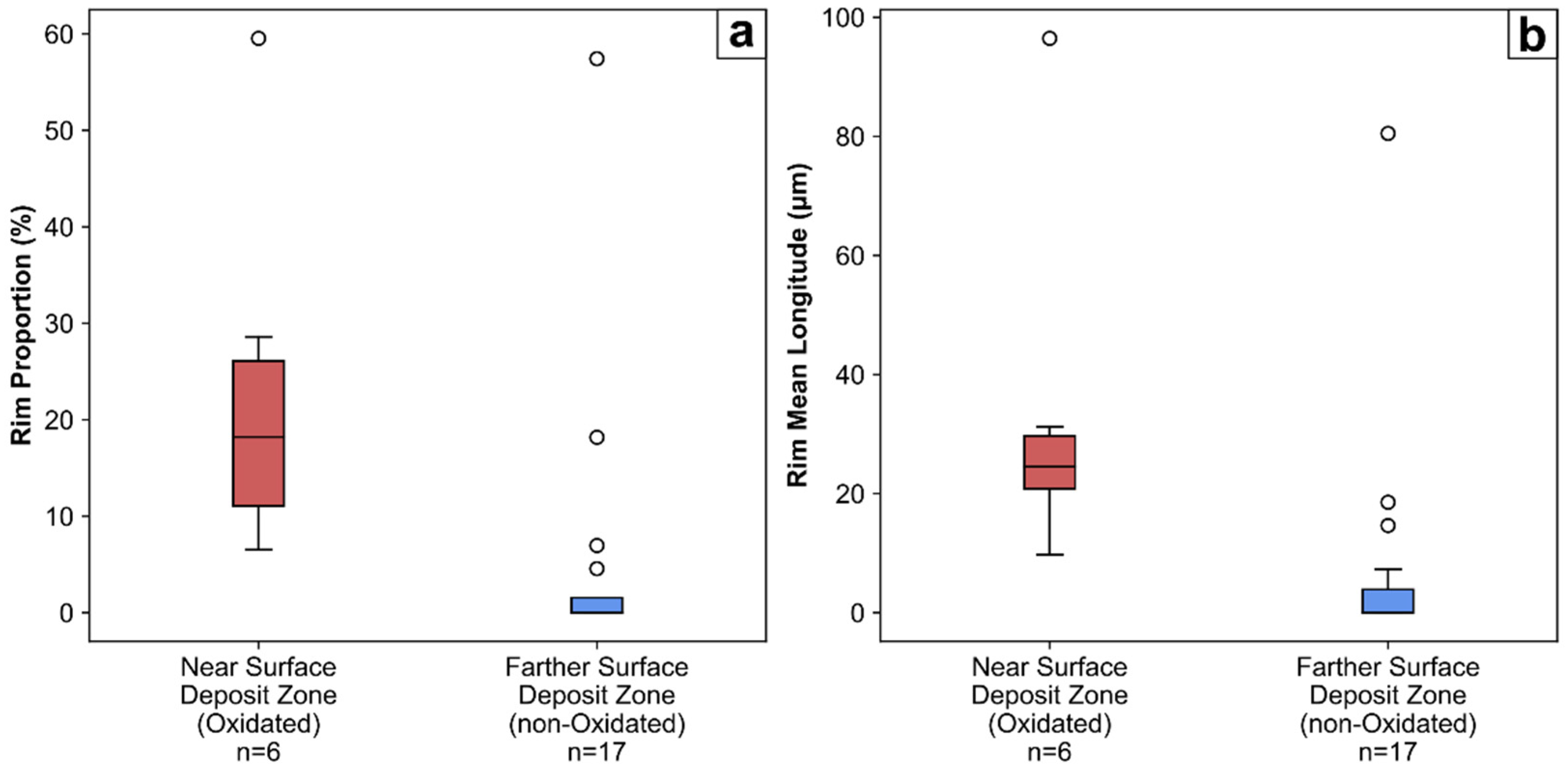
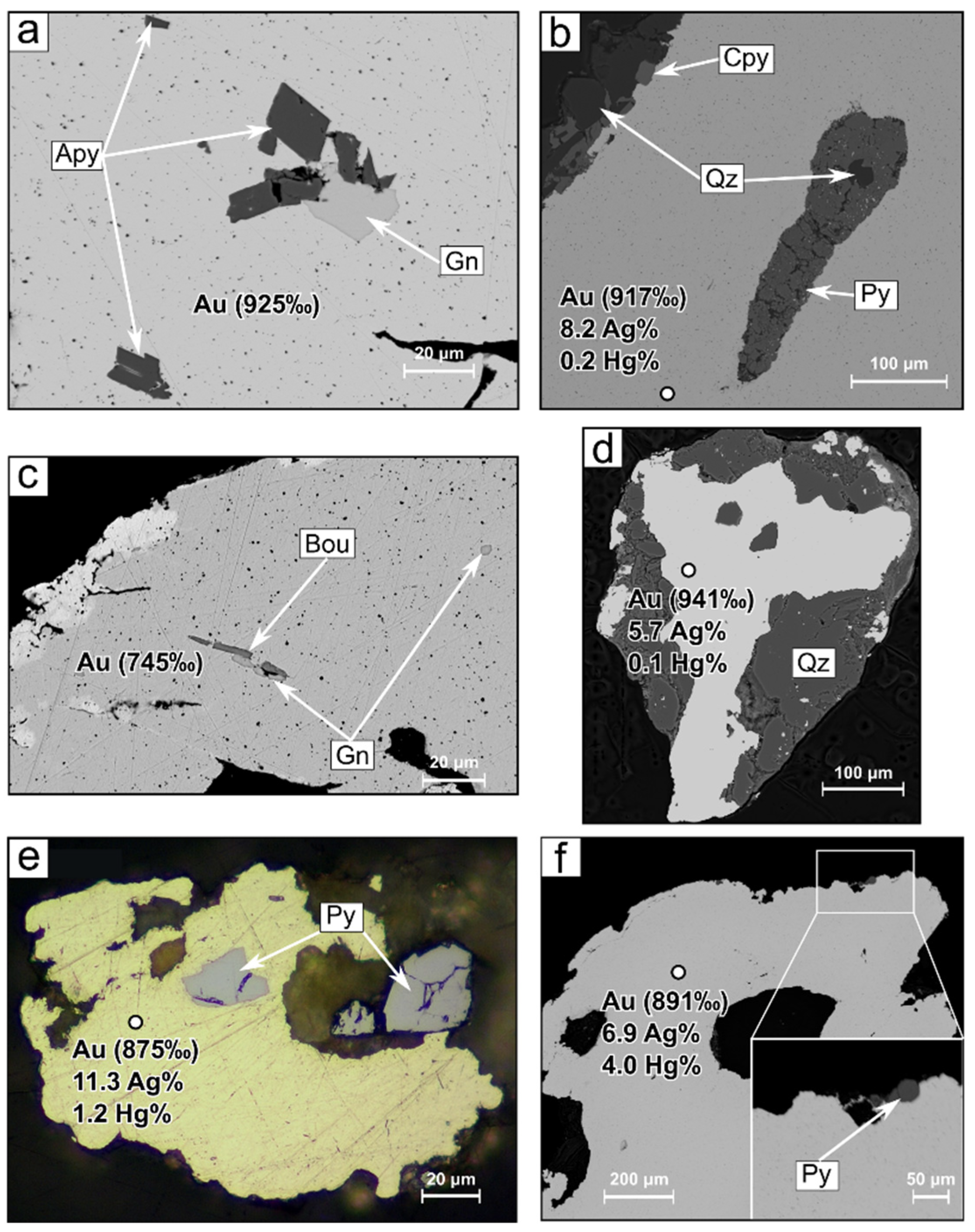

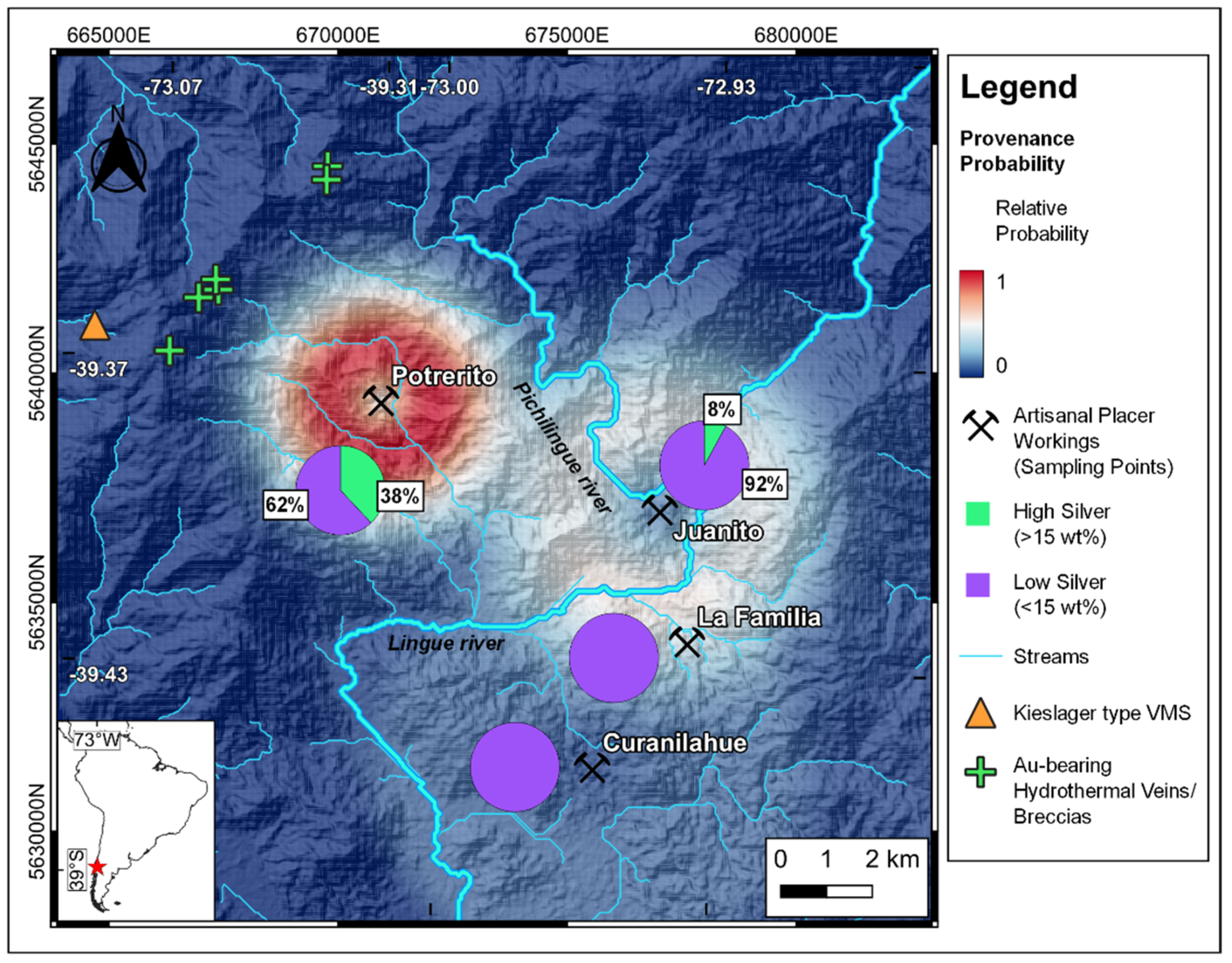

| Placer Location | Total Particles Analyzed | Particles with Ore Mineral Inclusions | Ore Mineral Inclusions |
|---|---|---|---|
| La Familia | 8 | 6 | Py, Gn, Apy, Cpy, Gdf |
| Juanito | 36 | 11 | Py, Gn, Cpy, Gdf |
| Potrerito | 26 | 11 | Py, Gn, Sp, Apy, Cpy, Tth, Blg |
| Curanilahue | 6 | 1 | Py, Apy, Gn |
Publisher’s Note: MDPI stays neutral with regard to jurisdictional claims in published maps and institutional affiliations. |
© 2022 by the authors. Licensee MDPI, Basel, Switzerland. This article is an open access article distributed under the terms and conditions of the Creative Commons Attribution (CC BY) license (https://creativecommons.org/licenses/by/4.0/).
Share and Cite
Becerra, P.; Sanchez-Alfaro, P.; Piquer, J.; Plissart, G.; Garroz, B.; Kunstmann, D. Gold Provenance in Placers from Pureo Area, Southern Chile Coastal Cordillera, and Their Relationship with Paleozoic Metamorphic Rocks. Minerals 2022, 12, 1147. https://doi.org/10.3390/min12091147
Becerra P, Sanchez-Alfaro P, Piquer J, Plissart G, Garroz B, Kunstmann D. Gold Provenance in Placers from Pureo Area, Southern Chile Coastal Cordillera, and Their Relationship with Paleozoic Metamorphic Rocks. Minerals. 2022; 12(9):1147. https://doi.org/10.3390/min12091147
Chicago/Turabian StyleBecerra, Pablo, Pablo Sanchez-Alfaro, José Piquer, Gaëlle Plissart, Belén Garroz, and Daniela Kunstmann. 2022. "Gold Provenance in Placers from Pureo Area, Southern Chile Coastal Cordillera, and Their Relationship with Paleozoic Metamorphic Rocks" Minerals 12, no. 9: 1147. https://doi.org/10.3390/min12091147
APA StyleBecerra, P., Sanchez-Alfaro, P., Piquer, J., Plissart, G., Garroz, B., & Kunstmann, D. (2022). Gold Provenance in Placers from Pureo Area, Southern Chile Coastal Cordillera, and Their Relationship with Paleozoic Metamorphic Rocks. Minerals, 12(9), 1147. https://doi.org/10.3390/min12091147





